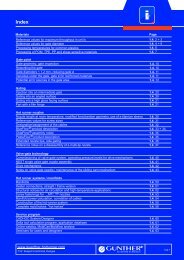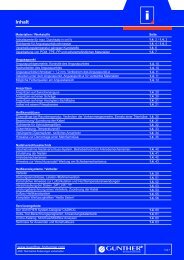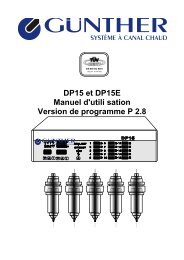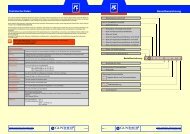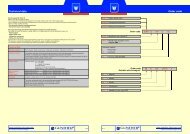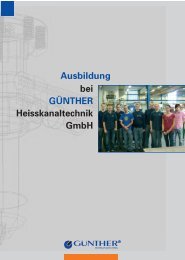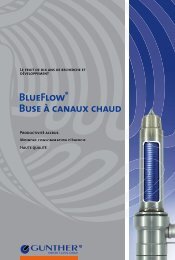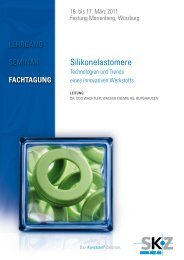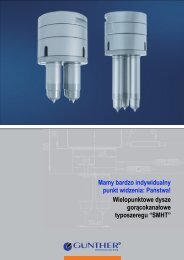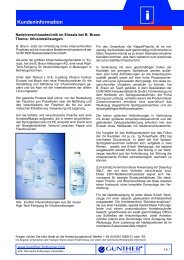Heißkanaldüsen Typ SLT/-DLT Customer information
Heißkanaldüsen Typ SLT/-DLT Customer information
Heißkanaldüsen Typ SLT/-DLT Customer information
You also want an ePaper? Increase the reach of your titles
YUMPU automatically turns print PDFs into web optimized ePapers that Google loves.
<strong>Heißkanaldüsen</strong> <strong>Typ</strong> <strong>SLT</strong>/-<strong>DLT</strong> <strong>Customer</strong> <strong>information</strong><br />
1.5. 20<br />
iA<br />
Hot-Runner Systems for High Injection Speeds<br />
In an X-Melt trial conducted in cooperation with the<br />
injection moulding machine manufacturer Engel,<br />
GÜNTHER Heisskanaltechnik GmbH in Frankenberg,<br />
subjected a two-cavity mould to a pressure of 2800 bar<br />
for half a second and checked the system for leaks. The<br />
injection trials were conducted with a test strip made of<br />
various materials with a wall thickness of 0.5 mm. The<br />
time for shooting the melt into the cavity varied from<br />
material to material and was 0.1 s for polystyrene, for<br />
example, and 0.04 s for LCP. The following are the<br />
results of the trial: the hot-runner system remained<br />
completely leak-tight at 2800 bar. No melt came out of<br />
the valve gate nozzles. Both cavities were filled<br />
simultaneously. A very high level of reproducibility could<br />
be attained. An example of an application for expansion<br />
injection moulding is the friction disk.<br />
Fig. For the expansion injection moulding of the friction disk an eightcavity<br />
hot-runner system with flat nozzles of the type 4NFT60LA is used.<br />
Friction disk<br />
Material<br />
Particle weight<br />
Wall thickness<br />
Gate diameter-ø 0.8 mm<br />
Hot runner<br />
Pitch center<br />
LCP<br />
0.02 g<br />
0.15 mm<br />
8-fold NV<br />
Hot runner nozzle 4NFT60 LA<br />
14 mm<br />
Fig. The LCP friction disk weihing 0.02 g can be produced with process<br />
reliability only with the expansion injection moulding method.<br />
(Photo: Schiebl)<br />
As trials have shown, reliable processes are possible<br />
only with expansion injection moulding. In this<br />
application a plastic part is injected onto a metal strip<br />
serving as a substrate. The disk is made of LCP, weighs<br />
0.02 g and has a wall thickness of 0.15 mm. The<br />
challenge in this project was to inject the very small<br />
quantity of material with process reliability. As the weight<br />
of the shot is so low, only valve gate systems can be<br />
used.<br />
A hot-runner nozzle specially designed for LCP<br />
processing was selected. The nozzle's material tube<br />
diameter was made narrower to reduce the viscosity of<br />
the LCP as a result of the higher shear.<br />
Abb. 8-fold hot runner system NV - friction disk of LCP<br />
Reduced weights and costs<br />
An important factor in physical foaming is that instead of<br />
expanding in the hot runner, the melt does not expand<br />
until it is the cavity. For that reason the hot-runner<br />
nozzles must maintain the pressure in the system after<br />
the injection of the melt and the subsequent closing until<br />
the blowing agent stays dissolved in the melt. This could<br />
be confirmed in trials. An example of an application is a<br />
car door lock housing with a wall thickness of 1.1 mm<br />
made of POM, which is produced with MuCell<br />
technology. The customer's aims were to cut costs by<br />
using less material and to shorten cycle time and reduce<br />
warpage and sink marks. The gas in the melt lowered the<br />
melt viscosity, which allowed a quicker injection. The<br />
microcellular foam allowed homogeneous shrinkage<br />
behaviour, which made it possible to avoid sink marks in<br />
thicker walls. The hot-runner nozzle used was a type<br />
8NLT80 nozzle from the supplier. The needles were<br />
actuated by hydraulically activated single needle valves.<br />
The customer's aims were to cut costs by using less<br />
material and to shorten cycle time and reduce warpage<br />
and sink marks. The gas in the melt lowered the melt<br />
viscosity, which allowed a quicker injection. The<br />
microcellular foam allowed homogeneous shrinkage<br />
behaviour, which made it possible to avoid sink marks in<br />
thicker walls. The hot-runner nozzle used was a type<br />
8NLT80 nozzle from the supplier. The needles were<br />
actuated by hydraulically activated single needle valves.<br />
For any questions, please contact our Application Engineering department at + 49 (0) 6451 5008-31 or -63.<br />
The <strong>information</strong> is given in accordance with our present-day knowledge and is meant to provide technical background.<br />
www.guenther-hotrunner.com<br />
Subject to technical changes 4/11



